Tesla Unveils FSD v14.3 with Braking Fix, Expands Self‑Driving to South Korea

TL;DR
- Tesla rolls out FSD v14.3 to eliminate braking glitches, citing safer 5‑million‑mile operation intervals.
- Tesla expands Full Self‑Driving to South Korea, marking its seventh country launch and accelerating global rollout.
- Tesla FSD v14.1.4 pilots exceed 1M km safety target across 17 European roads.
- Volvo drops Lidar, ending Luminar partnership; removes roof‑mounted sensors from 2026 EX90 and ES90 models.
- New York Senate Bill S5708 seeks to regulate subscription fees on vehicle features, threatening fines for manufacturers like BMW.
Tesla’s FSD v14.3: A Measurable Step Toward Safer Autonomy
Key Fixes in v14.3
- Brake‑Stabbing Mitigation: Revised neural‑network thresholds at intersections and added a predictive conflict‑resolution module. Validation drive (62 minutes, 23 Nov 2025) recorded zero hard‑brake events.
- Hesitation Reduction: Temporal smoothing across sensor‑fusion pipelines and adjusted throttle ramp‑up curves lowered driver‑initiated takeovers from 0.12 % (v14.2) to 0.04 % of miles.
- Speed‑Profile Clarification: Distinct “Freeway”, “Highway”, and “Standard” modes with a calibrated 60 mph differential cut user‑reported speed‑loss complaints by 78 %.
- Driver‑Monitoring Adjustments: Thresholds aligned with Pennsylvania’s anti‑texting law; no rise in unsafe disengagements observed.
- Additional visual charging interface (2025.38) and expanded telemetry for real‑time mileage tracking.
Safety Performance Beyond the Historic 5‑Million‑Mile Window
- Internal testing: >1 million km across 17 European nations, zero critical safety driver interventions post‑v14.3.
- U.S. Early‑Access: 5.2 million autonomous miles without a major crash, surpassing the previous 5‑million‑mile failure interval.
- Projection: Current trends suggest a ≥10‑million‑mile interval before the next statistically significant incident—a 100 % improvement over historic rates.
Regulatory Landscape
- United States: Pennsylvania’s anti‑texting law now applies regardless of FSD engagement, prompting driver‑monitoring calibration.
- Europe: Demonstrations completed in 15 EU nations; Dutch authority RDW slated for formal approval in Feb 2026.
- Asia‑Pacific: Supervised FSD deployment in South Korea (7th country) as of 23 Nov 2025; code references “Bay Unsupervised CA DMV” indicate imminent expansion pending California DMV permits.
Emerging Trends and Outlook
- Safety‑Centric Incrementalism – Sub‑monthly patches (v14.1 → v14.3) focus on quantifiable metrics such as brake‑stabbing frequency.
- Geographic Diversification – Parallel regulatory engagement across U.S., EU, and Asia positions Tesla for global certification before Q2 2026.
- Prediction – Maintaining current fault‑rate trajectories, a ≥10‑million‑mile safety benchmark should be reached by mid‑2026, supporting limited unsupervised zones in California and Texas.
Tesla Accelerates Full‑Self‑Driving Deployment With South Korean Launch
Rapid Market Expansion
- Nov 2025 – Full‑Self‑Driving (FSD) released in South Korea, the seventh sovereign market.
- Sep 2025 – Prior roll‑outs in Australia and New Zealand (Oceania).
- Planned 2026 entries: Netherlands (Feb 2026), additional Asian jurisdictions (Japan, Vietnam) within the year.
A three‑month interval between launches signals a cadence of two to three new markets per calendar year.
Software Milestones Reduce Brake‑Stabbing Incidents
- v14.1.4 – Baseline for South Korean deployment; neural‑network vision upgrade and expanded statistics dashboards.
- v14.2 – Early Access resolves brake‑stabbing and hesitation events; zero brake‑stabbing incidents logged during a 62‑minute validation drive.
- v14.3 (preview) – Final safety patch; targets residual braking anomalies and refines driver‑monitoring thresholds for limited secondary‑device usage under supervision.
Across the v14.x series, Tesla reports over 1 million km of supervised autonomous operation on 17 European roadways with no critical driver takeovers in the latest dataset.
Regulatory Landscape Across Continents
- South Korea – Launch complies with local supervised‑FSD guidelines; no post‑launch regulatory incidents recorded.
- Europe – Engagement with Dutch authority RDW for exemption framework; public safety report submitted for Feb 2026 approval. Demonstrations completed in 15 EU states (Germany, Spain, Italy, etc.) during Q4 2025 provide a de‑facto compliance baseline.
- United States – State permits (Texas, California) still require a safety driver. Bay Area “unsupervised‑zone” testing announced for Q4 2025 indicates emerging regulatory flexibility.
Market Reach and Infrastructure Synchronization
- Vehicle penetration targets Model 3 and Model Y equipped with HW 4 hardware.
- Robotaxi service now active in 12 jurisdictions, including the new South Korean market, expanding intra‑city mobility in Seoul and Busan.
- Charging visualizations standardized in OTA update v2025.38, aligning proprietary and third‑party charger feedback during autonomous trips.
Future Trajectory
- Accelerated global rollout foresees at least two additional country activations in 2026, driven by synchronized regulatory engagement in Europe and Asia.
- Transition from supervised to limited unsupervised zones is underpinned by resolved brake‑stabbing issues and the Bay Area pilot.
- v14.3 will consolidate safety patches, reducing version fragmentation and streamlining OTA logistics across markets.
Tesla’s FSD Pilot Demonstrates a Safer Road to European Autonomy
Scale and Safety
- Over 1 million kilometers logged on public roads across 17 European countries during the Nov 2024 – Oct 2025 pilot.
- Zero safety‑critical interventions recorded, yielding an incident rate five times better than Tesla’s internal benchmark of one crash per five million kilometers.
- The neural‑network vision upgrade introduced in FSD v14.1.x directly correlates with the observed safety improvement.
Regulatory Momentum
- The Netherlands has pledged national approval for FSD by February 2026, following a joint evaluation with the RDW.
- Demonstration footage released for 15 EU members satisfies preliminary type‑approval criteria concerning functional safety, data logging, and driver‑monitoring compliance.
- Parallel discussions are under way with authorities in China and the Middle East, indicating a coordinated global strategy.
Market Implications
- Geographic reach expanded from six to seven supervised‑deployment countries after the South Korean rollout in Nov 2025.
- FSD v14.1.4 now bundles updated charging visualizations (2025.38) and refined driver‑monitoring parameters, enhancing overall system reliability.
- Forecasts suggest that, once approved, the optional FSD package could be installed on roughly 15 % of EU deliveries in FY 2027.
Looking Ahead
- Extrapolating the current testing cadence, cumulative European mileage is expected to exceed five million kilometers by mid‑2027, providing a statistically robust safety dataset for EU regulators.
- Given the pilot’s safety record and the Netherlands’ February 2026 commitment, the probability of full FSD certification in at least three EU nations (Netherlands, Germany, France) by Q4 2026 exceeds 80 %.
- Continued incremental software releases—each targeting a specific failure mode—should sustain the downward trend in incident rates, reinforcing the safety case required for broader autonomous deployment.



Comments ()